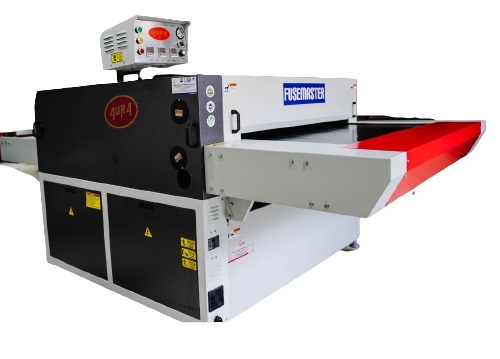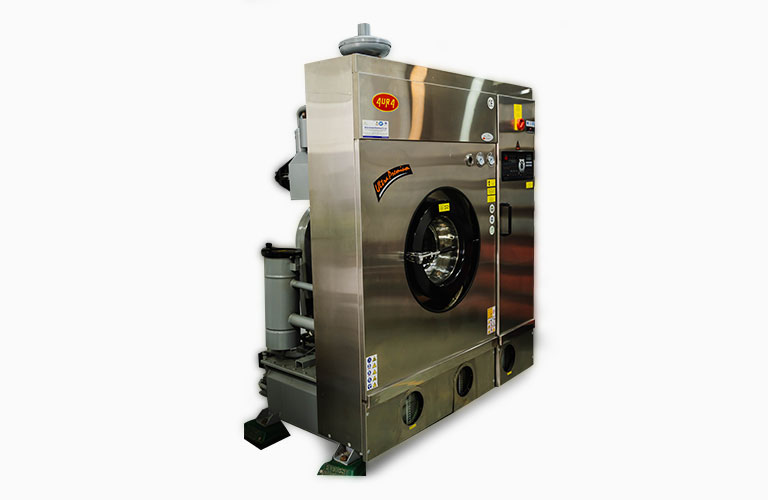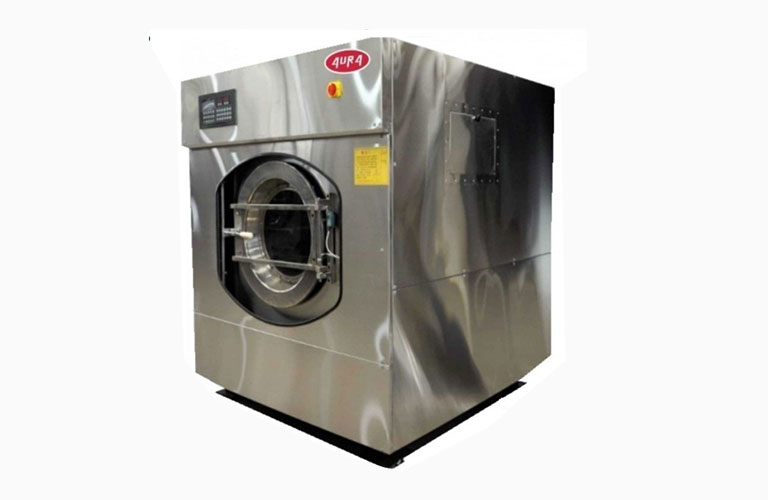
What is a Fusing Machine?
Fusing Machines are used in the garment industry to fuse a material capable of being fused to a base fabric through the process of pressure, heat, and time. The fused material should have acceptable strength, the ability to stand continuous wash, or any fabric treatment.
This extremely vital process that defines and maintains the quality of the garment involves holding the fabric and interlinking the conveyor belt while heating. This interlinking has adhesives that melt at a certain pressure and temperature to bond with the garment. This process provides the garment strength and support and thus is a highly vital process.
There are a number of fusing presses deployed in the process that makes the entire process of Fusing a quality procedure:
- Continuous Fusing Press
- Flatbed Fusing Press
- High-frequency Fusing
- Hand Iron
Continuous Fusing Press
In this machine, the parts of the garment and the interlining are placed one upon another properly for stiffening fabrics, among other things. On the endless loop or loop-shaped feed sheet and fed in a flat condition.
The feed sheet carries this part and the interlining to the fusing chamber. In the fusing chamber, the required pressure and heat are given.
To transmission of heat in the interlining, a direct or indirect method is applied. After applying heat, the required pressure is applied to the interlining with the help of a pair of roller irons.
The surface of the roller is generally covered by hard rubber. With the help of spring or pneumatic power, the pressure is created in rollers. And there is an arrangement of increasing or decreasing heat. The preselected time is determined through the control of the speed of the endless feed sheet.
Just after fusing, the fused parts are removed carefully from the delivery sheet and in a flat condition. Because during removal of the fused part in a heated condition., any folds created there may be permanent.
One worker is persistently feeding, and another worker is ceaselessly accepting the fused parts on the conveyance side.
The production of a continuous machine is high, and the quality of the fusing is also good. In some machines, for double fusing, there is an automatic feedback system. This is the most used machine in the garments industry. These are often used to apply the best tape that sticks to the fabric.
Advantages
- The production of a continuous machine is high.
- Quality of the fusing is good too.
- For these reasons, it is mostly used in the garments industry.
- Very reasonable for stack fabric utilizing
- There is no plausibility of fabric shrinkage
Disadvantages
- It is suitable for woven/knitting fabrics
- Whole role fabric and interlining are fusible because the pressure is applied for a short time on the interlining and the fabric. So, less chance of the plies of fabric being damaged.
- The pressure is applied for a short time, so there is no chance of fabric shrinking during the application of heat.
Uses/Application
- High cost.
- Because of its large area consumption, it’s difficult to construct.
- If the pressure roller is slanted or the surface of the roller is uneven for any reason, or there is a difference of pressure in the full diameter of the roller, the bond strength between the components will be different.
- Bacterias thrive in cold climates, and washing your laundry machine with cold water will not do much to sanitise the machine, and the garments would still be prone to both odour and germs. So, even though lower temperature fabric washing or machine cleaning can be environmentally friendly, it is not hygienic. This is especially true for garment industrial laundry machines or hospital laundry machines that deploy large-scale fabric cleaning.
- Therefore, besides using the detergent, make sure you use slightly warm water and disinfectant while garment washing. For machine cleaning, use a laundry cleaner and sanitiser every once in a while or every two months, depending upon the cycles of machine usage, to make sure the machine is thoroughly clean.
- There is a myth that surrounds people that the more soap you use, the more clean and sanitised your clothes will come out of the washing machine. However, using more suds only builds up as residue in the wash cycle, which is not entirely removed and becomes a breeding ground for bacteria and moulds. This also increases the odour of the garments and brings down the hygienic level of your fabric.
Flatbed Fusing Press
In this machine, there are generally two beds; one bed is static called ‘BUCK,’ and the other is moveable called ‘HEAD.’
The interlining and garment component is positioned first and placed on the BUCK. The top of the BUCK is covered by some soft beads made of fabrics, blankets, or silicone rubbers. The surface buck and head are covered with fabrics having a coating of PTFE. For this coating, the melted resins, dust, or spots can easily be cleaned.
The heating system may be electrical or steam. Application of temperature, pressure, and time could be pre-set in this machine; hence fusing conditions are adequately maintained.
First, the part of the garment, which is for fusing, is placed flatly. Then the resin surface of the interlining is placed carefully on this. Due to switch operation, the HEAD moves downward and comes in contact with BUCK, and pressure is applied on the component (interlining). Temperature is applied through HEAD on the whole surface, and after a specific time, the HEAD moves upward.
After applying pressure and heat up to a specific time, the HEAD is separated from the BUCK. Then for cooling of the fused parts, an air sucking fan in the buck is made operative. For sucking the air within the buck, the fused parts are cooled very swiftly. Going up off the HEAD and sucking of the air within the BUCK for a specific time. These jobs are set in cyclic order in many machines.
Advantages
- Temperature, pressure, and fusing time can be set again as per will.
- Except for pile fabrics, mostly for all fabrics, this machine can be used.
- Low cost.
- The natural ironing of garments can also be done with this machine.
- Tends to reduce fabric shrinkage.
- Easily cleanable.
Disadvantage
- Not suitable for large-scale production.
- To get good quality fusing, the temperature, pressure, and fusing time has to be checked.
- Sometimes, HEADS and BUCKS have to be changed.
High-Frequency Fusing
- This type of machine is quite different from a continuous fusing machine. Because in this machine, heat is created the same as a microwave cooker.
- Fabrics and interlining are arranged in stacks and placed between two metal plates of the fusing machine. The upper plate exerts pressure on the plies of the fabrics and the interlining with the help of spring pressure.
- The material between the plates moves at high speed. So high friction heat is generated within the material. This heat is generated uniformly at the same time on every corner of the fabric and interlining.
- For the generation of heat, water is a must. The difference between water vapour, the difference in heat may also happen.
- The required fusing time depends on the electrical power of the machine and the height of the lay of the fabric. But in this type of machine, it takes 1to 3 minutes for fusing
Advantages
- Production rate is high
Disadvantages
- Before fusing this type of machine lots of caution has to be taken care of. E.G., the setting, nature of the fibre, the height of the lay of the fabric, amount of water vapour in the fabrics.
- Proper settings of this machine are the main problem. Because of complicated settings, there may be over fusing or under fusing
- This type of machine is minimal
- Bigger risk of defective products.
Hand Iron
The interlining, which are fused comparatively in low temperature and pressure, are fused by using a hand iron. These are mostly used for applying lightweight fusible interfacing for applique.
There are various troubles during fusing; none of the three parameters of temperature, pressure, or fussing time can be adequately controlled. The operator approximates the time in this manner.
So, the strength of the bond in this method is weak. For better results after sewing the garment with the fusing, again, the final fusing is done
Just little parts can be fused with any level of progress, and afterward, only by pressing the iron for a fixed time onto the fusible, covering the region bit by bit, and utilizing steam to enable the warmth to move.
During the washing of the garments, the bond between interlining and garments may be separated.
What is the right way to wash your clothes in laundry equipment?
There are several commercial laundry equipment and an industrial machine that are available with cutting-edge features. While the machine's quality and usage are an important factor that decides the cleanliness and germ-free fabric, how you wash the garments is also a vital consideration here.
To make sure the garments come out of the machine clean and sanitised, follow the few simple tips:
Act at the Instant
Put your dirty laundry in the laundry equipment as soon as it needs cleaning. For the industrial or Hospital laundry machine, it becomes even more important because a bigger pile of clothes kept for some time directly correlates to the odour and germs
Also, try to put the laundry in a breathable laundry bag to allow some space for air to get in, which is a natural odour remover.
Turn the garments inside out
To prevent fabric wear and tear, turn the garments inside out before putting them inside the washing machine whenever possible.
Load the right amount of garments
Never overload your laundry equipment, whether commercial or industrial. Overloading restricts the complete elimination of unpleasant smells from the garments and also breeds bacteria or moulds.
A second wash cycle cannot harm
If you feel that the smell in the garments persists, give them another go in the washing machine to remove the odour completely. Once done, let them dry in the air. Natural air-dry clothes tend to have no smell than machine-dried clothes.
Read More



 A Guide to Industrial Washing Machine Needs!
Long gone are the days when hand washing clothes in river or pond water was the only resort people had. With the technology uprising, we have fabric-specific and industry-specific washing machines to make our lives easier and cater to distinct needs. However, there are a few things that still cannot be cleaned at your home, no matter how excellent or high-quality a washing machine you have.
This is especially true for those delicate clothes, expensive shoes, or the classy carpet..
A Guide to Industrial Washing Machine Needs!
Long gone are the days when hand washing clothes in river or pond water was the only resort people had. With the technology uprising, we have fabric-specific and industry-specific washing machines to make our lives easier and cater to distinct needs. However, there are a few things that still cannot be cleaned at your home, no matter how excellent or high-quality a washing machine you have.
This is especially true for those delicate clothes, expensive shoes, or the classy carpet..
 Eliminate Garment Odour and Sanitise it with Laundry Machines
It is never a pleasant experience to wear clothes that are fresh from the dryer but still exude a strong odour. Moreover, the current Pandemic has taken us down the road of hygiene diligently, and now a customer does not just expect clean clothes that are odour free but also sanitised.
And why not? Sanitisation is an essential requirement that keeps us protected against germs..
Eliminate Garment Odour and Sanitise it with Laundry Machines
It is never a pleasant experience to wear clothes that are fresh from the dryer but still exude a strong odour. Moreover, the current Pandemic has taken us down the road of hygiene diligently, and now a customer does not just expect clean clothes that are odour free but also sanitised.
And why not? Sanitisation is an essential requirement that keeps us protected against germs..
 What is a Fusing Machine?
Fusing Machines are used in the garment industry to fuse a material capable of being fused to a base fabric through the process of pressure, heat, and time. The fused material should have acceptable strength, the ability to stand continuous wash, or any fabric treatment.
This extremely vital process that defines and maintains the quality of the garment involves holding the fabric and interlinking the conveyor belt while heating..
What is a Fusing Machine?
Fusing Machines are used in the garment industry to fuse a material capable of being fused to a base fabric through the process of pressure, heat, and time. The fused material should have acceptable strength, the ability to stand continuous wash, or any fabric treatment.
This extremely vital process that defines and maintains the quality of the garment involves holding the fabric and interlinking the conveyor belt while heating..